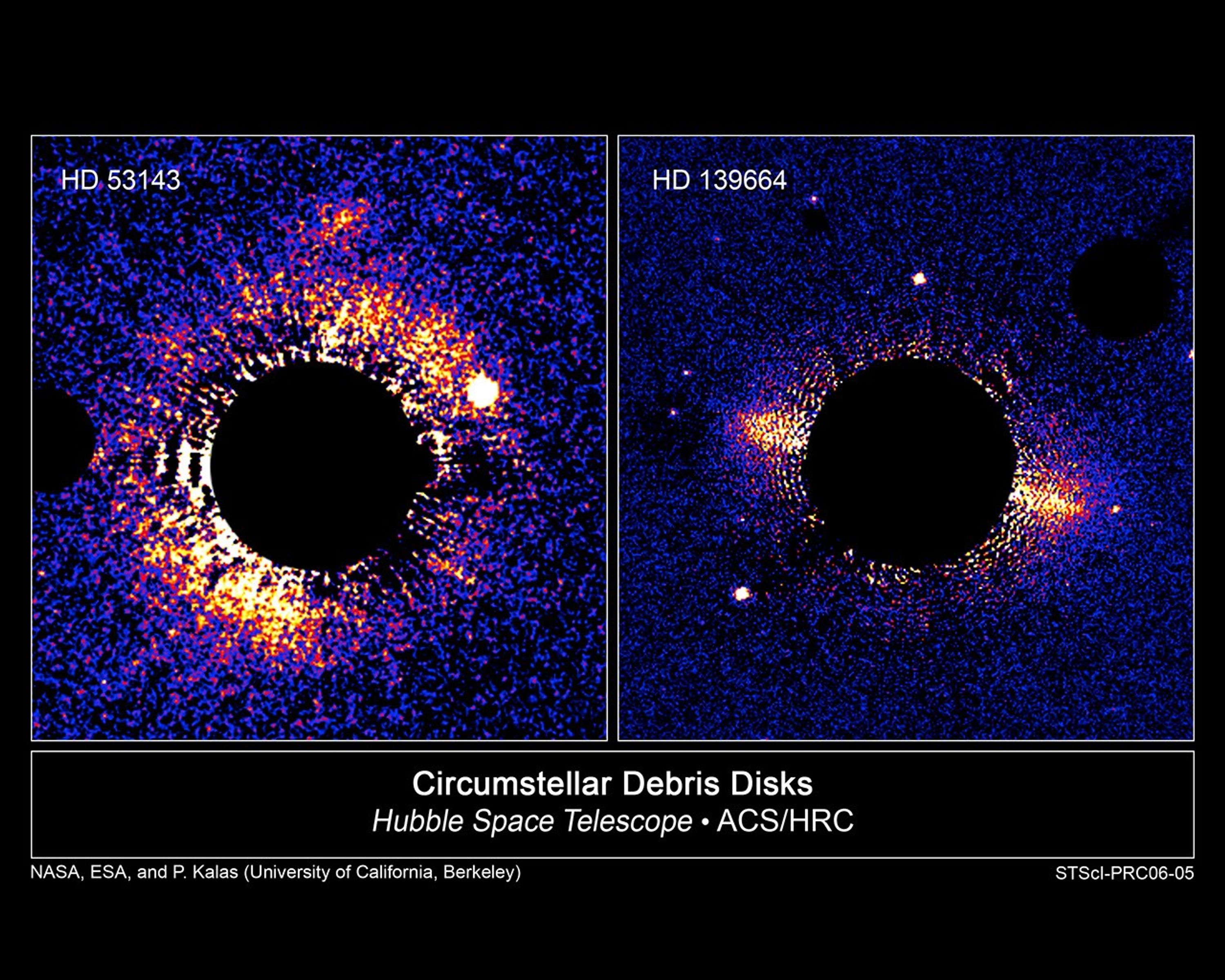1 min read
Dusty Planetary Disks Around Two Nearby Stars Resemble Our Kuiper Belt

These two bright debris disks of ice and dust appear to be the equivalent of our own solar system's Kuiper Belt, a ring of icy rocks outside the orbit of Neptune and the source of short-period comets. The disks encircle the types of stars around which there could be habitable zones and planets for life to develop. The disks seem to have a central area cleared of debris, perhaps by planets.
The new disks, each about 60 light-years from Earth, bring to nine the number of dusty debris disks observable at visible wavelengths. The new ones are different, however, in that they are old enough – more than 300 million years – to have settled into stable configurations akin to those in our own solar system, which is 4.6 billion years old.
The wide disk on the left, which is inclined obliquely to the line-of-sight, surrounds HD 53143, a K star slightly smaller than the Sun but about 1 billion years old. The narrow disk on the right, which is tipped nearly edge-on encircles the star HD 139664, an F star slightly larger than the Sun but only 300 million years old. The sharp outer edges of the narrow belt may be telltale evidence for the existence of an unseen companion object that gravitationally keeps debris gravitationally corralled, in the same way that shepherding moons trim the edges of debris rings around Saturn and Uranus.
A survey by NASA's Hubble Space Telescope shows that such disks fall into two categories: those with a broad belt, wider than about 50 astronomical units; and narrow ones with a width of between 20 and 30 AU and a sharp outer boundary, seemingly like our own Kuiper Belt. An astronomical unit, or AU, is the average distance between the Earth and Sun, about 93 million miles. Our Kuiper Belt, for example, is thought to be narrow, extending from the orbit of Neptune at 30 AU to about 50 AU.
The false-color images were taken with Hubble's Advanced Camera for Surveys in September 2004. The black central circle is an image artifact produced by the camera's coronagraph which blocks the glare from the central star to allow the much fainter disks to be seen. A smaller black circle at the edge of each photo is a "coronagraphic finger" also used to block light from a bright object in the field.
About the Data
- Data DescriptionData DescriptionProposal: A description of the observations, their scientific justification, and the links to the data available in the science archive.
Science Team: The astronomers who planned the observations and analyzed the data. "PI" refers to the Principal Investigator.The Hubble images were created from HST data from proposal 9475: P. Kalas (University of California, Berkeley), M. Clampin (NASA/GSFC), and J.R. Graham (University of California, Berkeley). - InstrumentInstrumentThe science instrument used to produce the data.HST>ACS/HRC
- Exposure DatesExposure DatesThe date(s) that the telescope made its observations and the total exposure time.September, 2004, Exposure Time: 1.3 hours
- FiltersFiltersThe camera filters that were used in the science observations.F606W (V), F892W (Methane)
- Object NameObject NameA name or catalog number that astronomers use to identify an astronomical object.HD 53143, HD 53143
- Object DescriptionObject DescriptionThe type of astronomical object.Star with Disks, Circumstellar Debris Disks
- Release DateJanuary 19, 2006
- Science ReleaseDusty Planetary Disks Around Two Nearby Stars Resemble Our Kuiper Belt
- Credit

Share
Details
Claire Andreoli
NASA’s Goddard Space Flight Center
Greenbelt, Maryland
claire.andreoli@nasa.gov






























